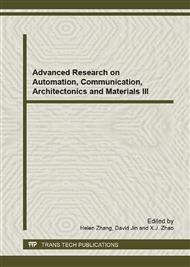p.7
p.13
p.18
p.22
p.26
p.30
p.34
p.38
p.42
Study on the Preparation of Strontium-Doped Hydroxyapatite Whisker
Abstract:
Hydroxyapatite is well used as bone repair materials, due to its properties that can be combined with strontium to improve mechanical property and degradation property. In this article, hydroxyapatite whiskers with different amount of doped strontium were prepared with diammonium phosphate, calcium nitrate and strontium nitrate at 94 °C. Fourier transform infrared spectroscopy (FTIR) was used to identify the functional groups. X-ray diffraction (XRD) analysis was carried out to study the phase composition and crystallinity of the whisker. The morphology of the whiskers was characterized by scanning electron microscope (SEM). It was indicated that strontium can be doped in hydroxyapatite with proper process and then the strontium-doped hydroxyapatite whiskers were produced successfully.
Info:
Periodical:
Pages:
26-29
Citation:
Online since:
August 2013
Authors:
Keywords:
Price:
Сopyright:
© 2013 Trans Tech Publications Ltd. All Rights Reserved
Share:
Citation:


